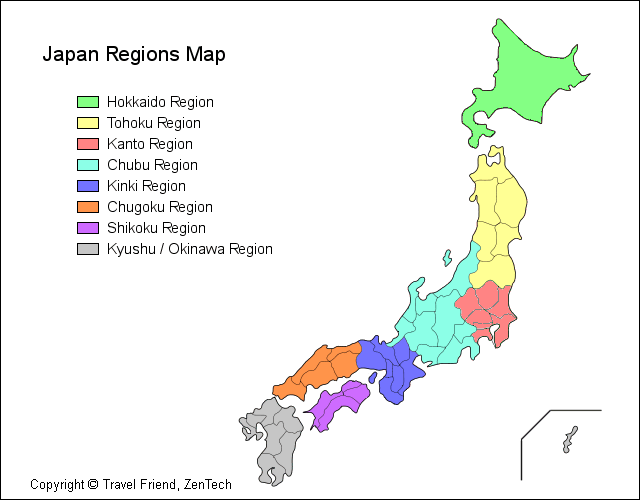
Before starting a new series about the musts of Osaka and Kobe, I'd like to put things a bit in perspective.
As presented in an earlier post Japan consists of thousands of islands, being Honshu 「本州」the biggest among all of them.
There are 8 main regions in Japan, 5 of which are located in Honshu, being Kansai「関西」(Kinki in the map below) and Kanto「関東」, the biggest and most prominent among all of them; where you are likely to spend most of your days in Japan.

West and East, haven rivaled for a long long time.
Kanto region symbolizes standardization throughout Japan and opening up to the World, during Meiji Restoration, first time in history for the Empress to wear Western-style clothing as an example.
Kansai displays many more idiosyncrasies and represents the focus of counterculture in Japan:
- Kyoto, the Culture
- Osaka, the Merchants
- Nara, the History
- Kobe, the Cosmopolitan Harbour
This East-West rivalry has deep historical roots, particularly from the Edo period, where the power shifted from Kyoto「京都」to Edo「江戸」(it would not be renamed to Tokyo「東京」until the Meiji emperor physically moved his residence there in 1868).
For those of you curious about kanji:
-「京」means "place where the Imperial Palace is"
-「都」means "metropolis"
-「東」means "east"
Consequently, Kyoto literally means "metropolis where the Imperial Palace is (i.e. Capital)" and Tokyo means "Eastern Capital". It is an Asian tradition to include the word capital 「京」 in the name of the capital city e.g. anyone heard of Beijing? Northern Capital「北京」; Nanjing? Southern Capital「南京」. By the way, all Japanese Kanji were imported from China - they mean the same, but are read differently.
What you need to remember is that, Tokyo may be the heart today, but Kansai is undeniably the place where it all started.
Nara, the most eastern point on the Silk Road, became the site of Japan's first permanent capital. This period (AD 710–784) kicked of the Buddhism to Japan and the construction of Tōdai-ji in 745.
During Heian period, the capital moved to Kyoto (then called Heian-kyō「平安京」) where it would remain for 1000 years until the Meiji Restoration.
During this golden age, the Kansai region gave birth to traditional Japanese culture:
- Noh and Kabuki, Japan's traditional dramatic forms both saw their birth and evolution in Kyoto.
- Bunraku, Japanese puppet theater, is native to Osaka.
- Geisha originated in Gyon 「祇園」a neighborhood of Kyoto.
- Along with so many temples and monasteries that you cannot even count.
Osaka, as supported by the saying "Kyotoites are ruined by overspending on clothing, Osakans are ruined by overspending on food" 「京の着倒れ、大阪の食い倒れ」is famous for its food. Osaka was a merchant city, with less than 1% of Samurai, in sharp contrast with Edo「江戸」which was, the seat of power for the Tokugawa shogunate 「江戸幕府」.
Kobe, besides excellent at Wagyu Beef, became an important hub for trade with China and other countries, with many foreigners residing until WWII started (ironically, in the plane back home, I watched a movie called "A boy called H" which captured the scene pretty well and how hard it is for long-term residents to leave Japan :_()
Kansai held power for thousands of years, but lacked damage from either war or natural disasters and has now more UNESCO listed sites than any other Region of Japan. Together with the great food and contrasting atmosphere (compared to Tokyo) is worth dropping by for a couple of days.





















No comments
Post a Comment